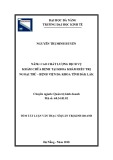
v
2.10 Screening for Depression in People with T2D ............................................................. 32
2.11 Measuring Depression in People with T2D ................................................................. 34
2.12 Quality of Life and Diabetic Foot Ulcers ..................................................................... 36
2.12.1 The Social Aspect .................................................................................................. 37
2.12.2 The Psychological Aspect ..................................................................................... 38
2.12.3 The Physical Aspect .............................................................................................. 39
2.14 Depression and Diabetic Foot Ulcers ........................................................................... 39
2.15 Research Gap and Theoretical Research Model .......................................................... 41
2.16 Research Hypotheses.................................................................................................... 42
Chapter III: Methodology ........................................................................................................ 43
3.1 Introduction .................................................................................................................... 43
3.2 Research Purpose and Design ........................................................................................ 43
3.3 Study Population Sample ............................................................................................... 44
3.3.1 Sample ..................................................................................................................... 44
3.3.2 Sampling Technique ................................................................................................ 45
3.4 Materials ......................................................................................................................... 45
3.4.1 Data Collection Instruments .................................................................................... 45
3.5 Study Approach .............................................................................................................. 49
3.6 Ethical Considerations.................................................................................................... 50
3.7 Data Analysis ................................................................................................................. 50
Chapter IV: Results .................................................................................................................. 52































